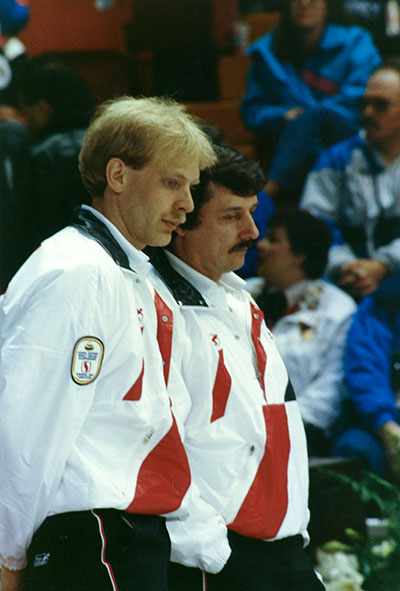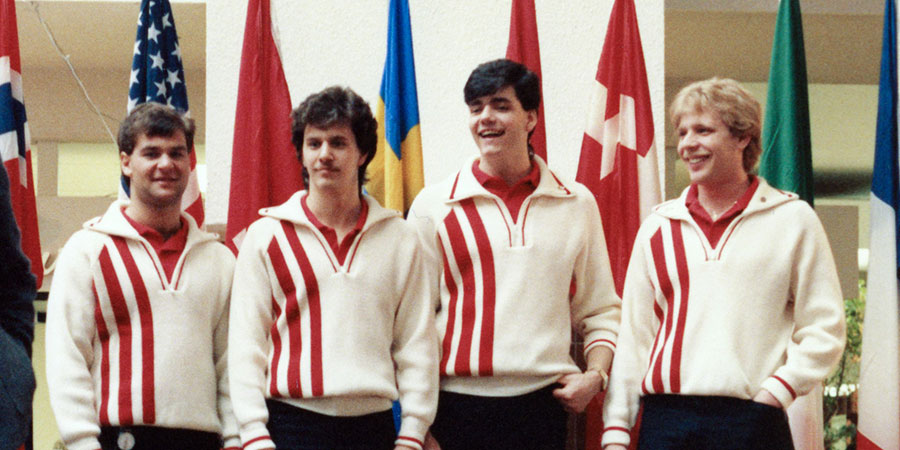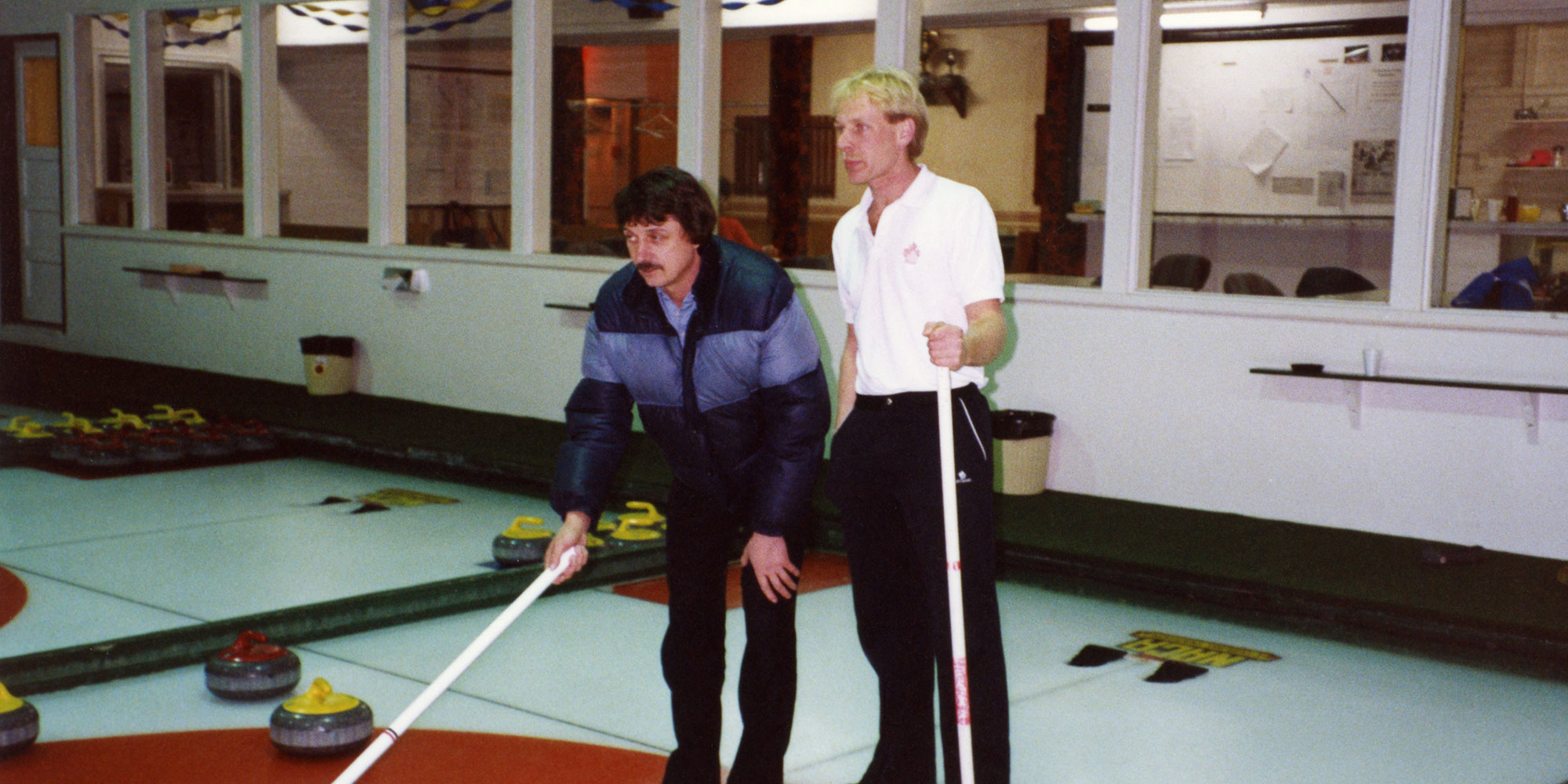Forged at NAIT, their relationship would make history in the sport
The most successful player-coach relationship in the history of curling started in fall 1984 when Kevin Martin, a kid with shaggy blonde hair, showed up at the office of Jules Owchar, asking to play for NAIT. A few practices later, a partnership was born that remains solid a quarter-century later.
It’s a late 1983 winter day in Edmonton, and NAIT curling coach Jules Owchar is in his customary position behind the glass of a sheet of curling ice. He’s coaching one of his star players, Rick Feeney, in the Northern Alberta junior men’s playdowns when he notices another junior a few sheets over. The kid, Kevin Martin, had an athletic build even then, and a shaggy mop of blonde hair. Owchar watched the kid throw a few shots, and followed his name for the rest of the playdowns, but never saw him throw another rock.
Fast forward to the following September and the same kid is in Owchar’s office, expressing his interesting in curling for Owchar’s famed NAIT program. A few practices later, Martin is skipping the Ooks men’s team, and a partnership is born that, a quarter-century later, is beyond question the most successful coach-player relationship in curling history.
 A long history together
A long history together
A junior national championship, four Brier titles, a world title, an Olympic silver medal and more cashpiel winnings than any player in history, with the greatest prize – gold at February’s Winter Olympics in Vancouver – still hanging tantalizingly within reach; to say the least, it’s been an enriching 25 years for both men.
Owchar, who spent 34 years at NAIT teaching phys ed before retiring in 2003, knew early on that Martin was destined for greatness. Sure, he threw the rock well. Nothing amazing there: lots of juniors are great throwers.
But Martin, a 1987 graduate of Petroleum Engineering Technology (and a Top 50 Alumni and 2010 honorary degree recipient) who makes no secret of the fact that he went to NAIT specifically because of Owchar, had something intangible that was put on display in 1985 when he skipped Feeney, Dan Petryk and Mike Berger to a national junior championship in the team’s first year together.
“You see a lot of juniors and they all look so good. But they just stay there,” says Owchar, who was inducted into the NAIT Athletics Wall of Fame the year he retired, and still coaches the school’s curling and golf teams. “Kevin was good, but as he went through cities, northerns and provincials, you could see as he was making shots that he was just not an ordinary curler. And he did the same thing in the nationals and the worlds.” In the 1986 world junior championship, Martin’s rink was undefeated until the final, losing to Scotland.
That first season together revealed that Martin and Owchar shared a passion for the mechanics of curling and the quest for a delivery that could be repeated with as little variance as possible hundreds, if not thousands, of times in succession so that regardless of the circumstance – a practice at the Avonair Curling Club or a draw to the four-foot to win the Brier – the delivery would stand up to the pressure.
“Consistency and mechanics are the same thing,” says Martin. “Tiger or Phil Mickelson, they’re so technically sound. They’re not going to win every time they go out. But you know what? They’re going to be pretty tough every time. That’s where Jules has been such a help. We’re not going to win every time, but we’re going to be pretty good every time. And over the long haul, you win quite a lot.”
Today, Owchar’s trained eye can spot the slightest flaw in Martin’s delivery, and is one of the few people Martin will take input from. “They seem to know each other without having to say too much,” said Martin’s second, Marc Kennedy. “He is one of the only guys who can tell Kevin what he should be doing mechanically. And Kevin listens. He’s a beaut.”
Challenges early on
Off the ice, the relationship quickly evolved from that of teacher and student to friends. Not that there weren’t some early hiccups. Take, for instance, the closing banquet at the 1985 national juniors. “Oh, yeah, he definitely read me the riot act,” recalls Martin of that night. “We weren’t acting the way we probably should at a Canadian championship.” Which is all Martin is willing to say about that night.
Owchar, though, fills in the blanks. “It was a big function, and someone said to me that I better go see the (team’s skip and lead),” chuckles Owchar. “They had their suit coats on, and their pants off and they’re dancing in their shorts. With all the dignitaries there.”
Owchar had a cringe-worthy moment of his own, though, a few weeks earlier when coaching Martin at the Alberta college championships in Calgary. Martin was down to a team from Red Deer, and just prior to the fifth-end break, Owchar ducked out of the building to place a bet on a hot prospect in a harness race at the Stampede Park racetrack, just across the parking lot. While he was gone, Martin found himself in the middle of a massive dust-up on the ice. And his coach was nowhere in sight.
“There was a big row on the ice because we got the corn brooms out at the fifth-end break,” relates Martin, referring to the since-banned practice of changing from push-brooms to corn brooms in order to leave debris on the ice. “All hell was breaking loose, the game had stopped – I mean, the place was going crazy.”
“I don’t remember the name of the horse, but I know Jervis Clifton was driving,” says Owchar, laughing as he tells the story. “The racetrack is, what, three minutes away? So we just went and made the bet and came back. And when I came back, everybody was looking at me like I had committed hara-kiri. I had no idea what was going on.”
For what it’s worth, Martin came back to win that game. And another page was added to the Martin-Owchar legend book.
For all the success Martin and Owchar have enjoyed together, it’s a stark reality that Martin’s career is notable, in the public eye anyway, more for the losses than the wins, beginning with that world junior final setback.
“Yeah, we used to kid about it, that we had to win because we had no more room on our foreheads for the Ls,” says Owchar. “Oh, we took some (losses); we took some wicked ones.”
In later years, Martin would lose the 1991 world final (again to Scotland) in Winnipeg, the 1992 Olympic semifinal (when curling was a demonstration sport in Albertville), the 1997 world men’s semifinal to Sweden and the 2002 Olympic gold-medal final to Norway, leading naysayers to sneer that Martin was at his best with money on the line in domestic competitions, but couldn’t win big with a Maple Leaf on his back.
The rivalries

Martin, with his current team (he was joined by John Morris, Kennedy and Ben Hebert prior to the 2006-07 season), finally erased that stigma in 2008, winning his first world title by beating David Murdoch’s Scottish champs in the gold-medal game at Grand Forks, N.D.
But a year later in Moncton, N.B., in a gold-medal game that featured one of the most talked-about curling shots in history, Martin fell short to Murdoch when the Scots came back from a two-point deficit through eight ends, and stole the winning point in the 10th.
The shot in question was actually a non-shot: Martin intentionally tossed his first rock of the 10th end through the rings, believing he would do more harm than good by putting the rock in play. The decision stunned the 5,300 fans in attendance and hundreds of thousands watching at home – and surprised his coach.
“I saw what he was doing, but I never dreamt he would do it,” says Owchar. “It surprised me completely; I’m never shocked by what he does, but I wasn’t sure what he was going to do.” In the end, Martin still had a shot for the victory (as he predicted he would before the throw-through), but he missed, touching off weeks of second-guessing, but not (publicly, at least) from his coach.
“There’s not much to say,” adds Martin with a shrug. “He knows exactly what I was thinking. We do win around 90 per cent of the games we play, and sometimes the decisions you make produce a lot of points. And sometimes they don’t work out.”
It’s quite conceivable that Martin and Murdoch will renew acquaintance at the 2010 Games; Murdoch has been named to Great Britain’s Olympic squad, with the final team to be named in December, and Martin has to get through December’s Olympic trials in Edmonton.
“I don’t think it would be a surprise; those guys have been at the top of their game for the last two years, and you see the way they ripped through the Brier the last two years and the world championship barring the last three games,” said Murdoch, who has skipped in four of the past five world finals, winning twice. “Those guys are playing extremely well. It will be tough for them; Glenn (Howard) will be wanting to get back to the top, and you have the re-emergence of Randy (Ferbey) and his team; they seem to have fire in their stomach again. It will be interesting to watch.”
Entry into the World Curling Hall of Fame
On March 3, 2018, NAIT alum Kevin Martin was inducted into the World Culring Hall of Fame during a ceremony in Las Vegas.
Former coach Jules Owchar was in attendance.
Over his career, Martin earned the titles of Olympic, world and Canadian championship and amassed awards such as MVP and all-star skip.
"This is a tremendous honour," Martin said. "When you're a kid and you start playing a sport you don't think about days like today."
Local competition
Ferbey, for one, has spent the better part of two decades scrapping with Martin, on and off the ice, establishing the best rivalry in the sport’s history. And while he has plenty of respect for his former teammate (they spent two months together in 1995 before parting ways), he’s not sure Martin’s team has done enough to establish itself as the best ever.
“How do you define the best?” Ferbey asked shortly before the Brier. “I don’t know. If they go on to win five world championships, Number 1 on the money list for five years, lose only a handful of games, I’ll bow down to them. But until then, yikes, you’ll have every guy gunning for you big time, and other teams will be formed to go up against you.”
Timing is everything in sports, and should Martin and Owchar (along with Morris, Kennedy and Hebert) have it going their way, they’ll prevail at the Olympic trials to earn the right to represent Canada in Vancouver.
Owchar will be in his customary position, behind a sheet of curling ice, watching the man he helped mould into one of the world’s finest curlers. “I guess that would just crown everything off for the two of us,” says Owchar. “For 25 years, we’ve done a lot of work together.
“(The Olympics) are big for us, and Kevin is probably thinking that maybe it’s the last chance to go. To him, it’s the biggest event. I know we will be prepared. The schedule will be set properly. There will be no excuses. We’ll go in, and we’ll be ready to shoot our 90-plus (per cent) and hope that’s good enough. If it isn’t, we’ll offer our congratulations.”
Originally published in techlife magazine, 2009
